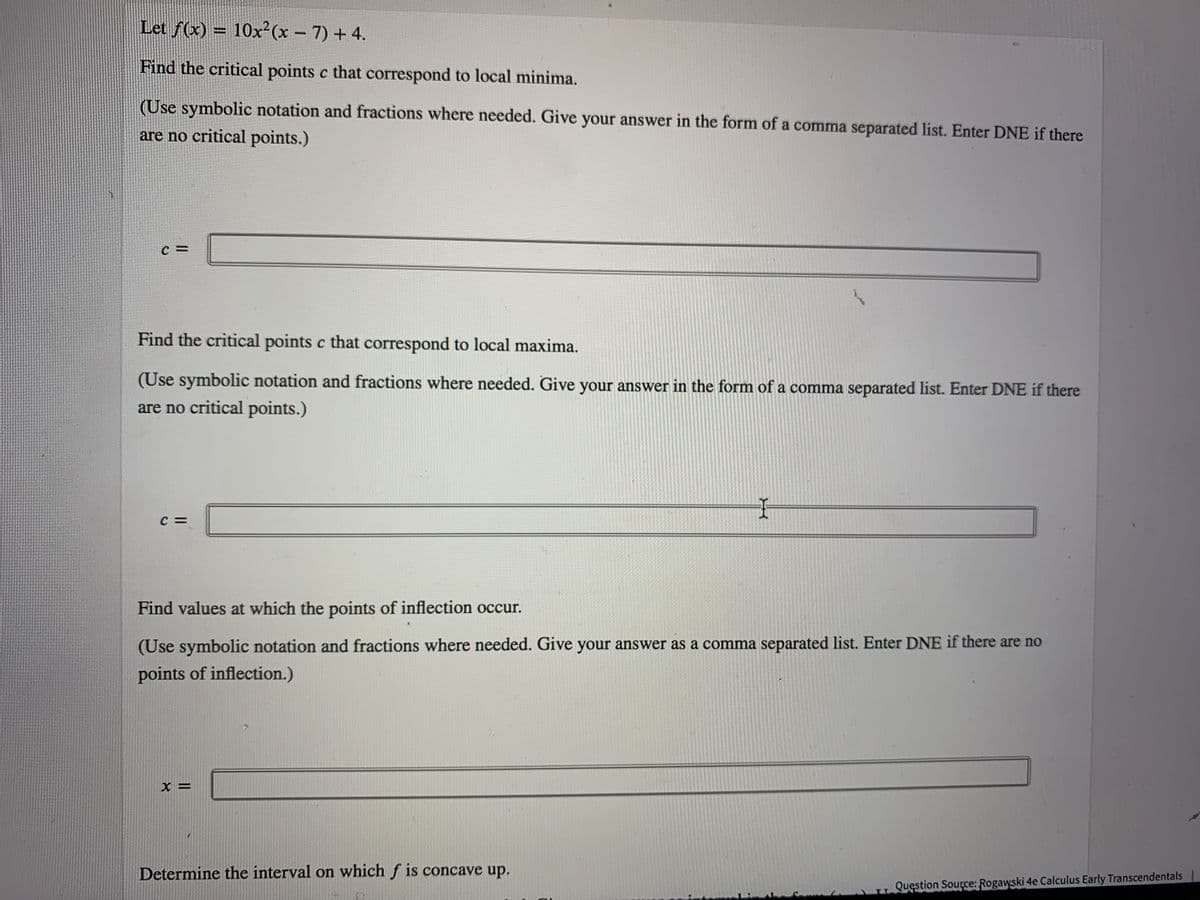Let f(x) = 10x²(x-7) +4. Find the critical points c that correspond to local minima. (Use symbolic notation and fractions where needed. Give your answer in the form of a comma separated list. Enter DNE if there are no critical points.) C = Find the critical points c that correspond to local maxima. (Use symbolic notation and fractions where needed. Give your answer in the form of a comma separated list. Enter DNE if there are no critical points.) C = Find values at which the points of inflection occur. (Use symbolic notation and fractions where needed. Give your answer as a comma separated list. Enter DNE if there are no points of inflection.) = x Determine the interval on which f is concave up. Question Source: Rogawski 4e Calculus Early Transcendentals
Let f(x) = 10x²(x-7) +4. Find the critical points c that correspond to local minima. (Use symbolic notation and fractions where needed. Give your answer in the form of a comma separated list. Enter DNE if there are no critical points.) C = Find the critical points c that correspond to local maxima. (Use symbolic notation and fractions where needed. Give your answer in the form of a comma separated list. Enter DNE if there are no critical points.) C = Find values at which the points of inflection occur. (Use symbolic notation and fractions where needed. Give your answer as a comma separated list. Enter DNE if there are no points of inflection.) = x Determine the interval on which f is concave up. Question Source: Rogawski 4e Calculus Early Transcendentals
Algebra & Trigonometry with Analytic Geometry
13th Edition
ISBN:9781133382119
Author:Swokowski
Publisher:Swokowski
Chapter5: Inverse, Exponential, And Logarithmic Functions
Section5.1: Inverse Functions
Problem 17E
Related questions
Question

Transcribed Image Text:Let f(x) = 10x²(x- 7) + 4.
Find the critical points c that correspond to local minima.
(Use symbolic notation and fractions where needed. Give your answer in the form of a comma separated list. Enter DNE if there
are no critical points.)
C =
Find the critical points c that correspond to local maxima.
(Use symbolic notation and fractions where needed. Give your answer in the form of a comma separated list. Enter DNE if there
are no critical points.)
C =
Find values at which the points of inflection occur.
(Use symbolic notation and fractions where needed. Give your answer as a comma separated list. Enter DNE if there are no
points of inflection.)
X =
Determine the interval on which f is concave up.
Question Source: Rogawski 4e Calculus Early Transcendentals
![(Use symbolic notation and fractions where needed. Give your answer as a comma separated list. Enter DNE if there are no
points of inflection.)
Determine the interval on which f is concave up.
(Use symbolic notation and fractions where needed. Give your answer as interval in the form (*,*). Use the symbol co for
infinity, U for combining intervals, and an appropriate type of parenthesis "(", ")", "[", "J" depending on whether the interval is
open or closed. Enter Ø if the interval is empty.)
x E
Determine the interval on which f is concave down.
(Use symbolic notation and fractions where needed. Give your answer as interval in the form (*, *). Use the symbol co for
infinity, U for combining intervals, and an appropriate type of parenthesis "(", ")", "[", "]" depending on whether the interval is
open or closed. Enter Ø if the interval is empty.)](/v2/_next/image?url=https%3A%2F%2Fcontent.bartleby.com%2Fqna-images%2Fquestion%2F44bcc854-a672-4b6c-b0fb-367be49d6297%2F39c6932c-998c-4e7e-90fb-9f06897356f7%2F1eyybm_processed.jpeg&w=3840&q=75)
Transcribed Image Text:(Use symbolic notation and fractions where needed. Give your answer as a comma separated list. Enter DNE if there are no
points of inflection.)
Determine the interval on which f is concave up.
(Use symbolic notation and fractions where needed. Give your answer as interval in the form (*,*). Use the symbol co for
infinity, U for combining intervals, and an appropriate type of parenthesis "(", ")", "[", "J" depending on whether the interval is
open or closed. Enter Ø if the interval is empty.)
x E
Determine the interval on which f is concave down.
(Use symbolic notation and fractions where needed. Give your answer as interval in the form (*, *). Use the symbol co for
infinity, U for combining intervals, and an appropriate type of parenthesis "(", ")", "[", "]" depending on whether the interval is
open or closed. Enter Ø if the interval is empty.)
Expert Solution
This question has been solved!
Explore an expertly crafted, step-by-step solution for a thorough understanding of key concepts.
Step by step
Solved in 3 steps with 2 images

Recommended textbooks for you

Algebra & Trigonometry with Analytic Geometry
Algebra
ISBN:
9781133382119
Author:
Swokowski
Publisher:
Cengage

Algebra & Trigonometry with Analytic Geometry
Algebra
ISBN:
9781133382119
Author:
Swokowski
Publisher:
Cengage